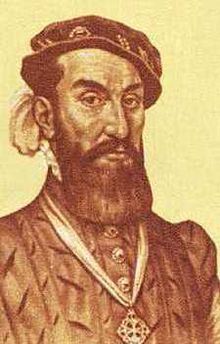Cabeza de Vaca: Explorer of the Lone Star State
 In November of 1528, Conquistador Álvar Núñez Cabeza de Vaca and his crew of 90 Spaniards crashed on Galveston Island. He was the first European to set foot on the land that would become the Lone Star State and is considered to have undertaken one of the most remarkable journeys in the history of American exploration.
In November of 1528, Conquistador Álvar Núñez Cabeza de Vaca and his crew of 90 Spaniards crashed on Galveston Island. He was the first European to set foot on the land that would become the Lone Star State and is considered to have undertaken one of the most remarkable journeys in the history of American exploration.
From 1528 to 1532, the crew steadily died off from illness, accidents, and attacks until only Cabeza de Vaca and three others remained. During those four years, Cabeza de Vaca became a merchant, and traded seas shells and ``beads of sea'' (though now called pearls) for bison skins and red ochre.
He also gained a reputation as a healer, which gave him freedom to travel between different tribes.
The Karankawa Indians, a group of Coahuiltecans known to be cannibals, enslaved these men until, in September of 1534, the four men snuck away from the Karankawas and fled south towards the Rio Grande River. The following spring, they finally crossed the Rio Grande and made it to Mexico. To avoid hostile tribes, the men turned west towards the Pacific and crossed northern Mexico.
Cabeza de Vaca and his companions eventually arrived in Mexico City in 1536.
They had traveled nearly 2400 miles over eight years in Texas and the Mexican borderlands.
Cabeza de Vaca spent years interacting with Native Americans and learning their language. This allowed him to write and publish in 1542 the first book about Texas, the Relacion, which contained information about the region's geography, landscape, and Coahuiltecan tribes. This account of his journey inspired other conquistadors and Spaniards to cotne and explore Texas.
And that's just the way it is.



